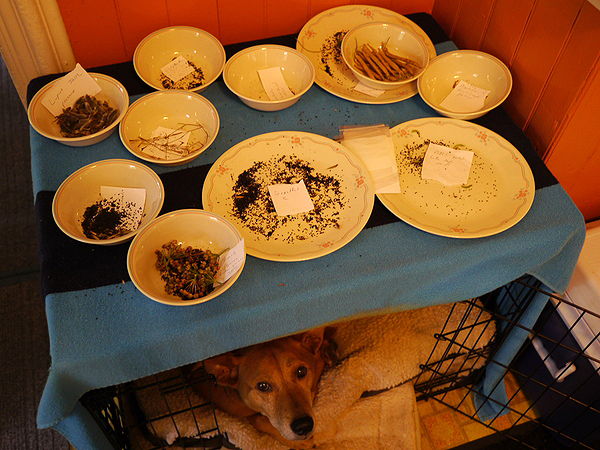

Since early July there’s been a growing collection of plates and bowls on the top of my dog’s crate.
Each also has a small piece of paper and on it, written in some Latin, some English and a date. Can you guess what is in these plates and bowls?
No, not doggie treats.
These containers instead have a particular amalgam of garden chaff, stems, pods and seeds. Lots and lots of seeds: columbine, dianthus, wild sweet pea, primula, rudbeckia, verbascum, althea, digitalis, allium, aster and cimicifuga, to name a few.
The collecting will go on for a few more weeks but one day soon I’ll sit down and start to pack the seeds into foil pouches and glassine envelopes that will go into small plastic bags. Eventually, they’ll go into a box that will join several other boxes in my refrigerator.
It’s a ritual for me, one that I can’t resist, and it’s as strong an urge and instinct in me as it is for birds to migrate or bears to hibernate. I’m a seed saver.
From these seeds I have the ability to grow hundreds to thousands of plants at little to no cost. Last year I collected the seed from a wonderful primula known as “Miller’s Crimson.” I wanted more, lots more.
When the pair of plants in my garden set seed I collected them. And yes, the seeds went into the kitchen, on the kitchen table and sat for a few weeks on a plate with a paper tag. Last week I planted 200 of those progeny and come next spring I hope to have several drifts of Miller’s Crimson in my shaded garden.
My own interest in seed saving is in hardy perennials and some unusual annuals but I’m sure there are those of you who are interested in saving vegetable seeds as well, especially if you grow heirlooms. The basic concepts are the same, though with my varieties I just never know where or when I’ll spot a plant that will strike my fancy. With vegetables being primarily confined to the vegetable garden, the spotting and collection is a bit more routine, though you still need some background knowledge.
Many gardeners wonder if they can save seeds from plants grown in their own gardens and avoid the expense of buying seed the following year. The answer is yes. And no. It can be done, but if you don’t know what you are doing, you may end up wasting your time and effort.
The key to successful seed saving lies in knowing what crops and varieties bear seed that is likely to produce plants that are similar to the parent plants. After all, the idea behind saving tomato seeds is to get good quality tomatoes.
Understanding a few terms will be useful in determining what seed is savable.
Hybrid seed is produced through controlled pollination using two specific varieties that have been inbred, or self-pollinated, for many generations to produce particular traits. The parent plants may have weak growth or other poor characteristics, but when crossed, their seed produces desirable plants.
Only the first generation of seed resulting from the cross of the parent plants, the F1-hybrid generation, will produce the exact combination of desired traits. Future generations may revert to the undesirable traits of the parent plants.
For this reason, seed saved from hybrid plants will generally produce plants that are inferior. Hence the first rule of seed saving: do not save seed from hybrid plants.
Though this does not mean that seed from all non-hybrid plants can be saved and planted with good results either. If the non-hybrid is self-pollinated, the seed will produce plants similar to the parent plants and is a good candidate for saving.
Some popular garden plants that are also self-pollinated are tomatoes, peppers, beans, peas and lettuce. If the plant is pollinated by neighboring plants of a different variety—such as cucumbers, corn and squash can be—any seed produced will be of mixed parentage and will produce mixed results.
Since pollen can travel a long distance from other gardens with insects or on the wind, it would be wise to limit your seed-saving efforts to self-pollinated, non-hybrid varieties.
Once you determine that you have some plants whose seeds are worth saving (or even if you just want to try for the sheer fun and mystery), you need to harvest and store the seed properly. Fruit must be fully ripe; for tomatoes that means riper than you’d like to eat them. Peppers may begin to shrivel when they are completely ripe, but don’t wait until the fruit begins to rot.
Remove the seed from the flesh and allow it to dry. Tomato seeds can be separated by allowing the pulp to ferment with a little water for a few days, after which the seeds can be strained off and dried.
Seeds such as beans and peas that grow in pods are simple to process. Pick the pods as they dry, but before they shatter, and remove the seed. Allow the seed to dry thoroughly in a warm spot out of direct sun and then package the seed in envelopes or jars, storing it in a cool, dry spot.
If using glass jars for storage, check the side of the jars for condensation after a few days of storage. If it is present, dry the seeds some more before storing them.
If the seed has not been allowed to adequately dry and you store it, you virtually guarantee that you will end up with mold and fungus problem. The converse is that seed can be overdried and this can result in its loosing viability or going into an unwanted dormancy.
I have my own particular regime to save seeds. Once the seed has been collected, I allow it to sit in a bright, dry room for at least a day.
Once I have dried the seed, I cut a 4-by-4-inch square of aluminum foil and place the seed in the center. The foil is then folded into quarters with the seed enclosed and the edges folded to create a somewhat airtight seal. This packet then goes into a small 3-inch-by-5-inch resealable plastic bag or a glassine envelope that has a writable section on the outside.
I put a piece of paper inside the bag identifying the seed and date collected. The same information goes on the writable section of the plastic bag.
Next, the seed goes into the refrigerator and stays there until it is ready for sowing indoors or out. Seed should never be stored in the freezer, and while this was once a common practice we’ve since learned that nearly all freezer-stored seed becomes unviable.
An alternative is to save seed in the refrigerator in plastic 35-millimeter film cans, if you can find any. But again, remember to label the cans or they’ll be useless when you need to know what they contain.
Another no-no is storing seed in modern refrigerators in paper bags. Modern frost-free refrigerators suck the moisture right out of the refrigeration compartment, resulting in no moisture, no frost and no ice.
But seeds stored in paper bags suffer the same fate. The moisture is sucked out of them and they become unviable, hence the need for plastic bags, foil or plastic container protection.
Seed collecting and growing your own plants from your own seeds can be great fun. It can also be challenging.
Ever try to collect seed from an impatien or balsam plant? There is a reason why they are called impatiens.
Marigolds are easy, as are cleome and sunflowers. But if they are non-hybrids and there are other colors or similar varieties nearby, be ready for some surprises. At the same time remember that it’s these surprises that have given our gardens many of the plants we use today.
Maybe the next rage in the form of a new breed of petunia, marigold or perennial hibiscus will come from your garden. Keep growing.
 More Posts from Andrew Messinger
More Posts from Andrew Messinger